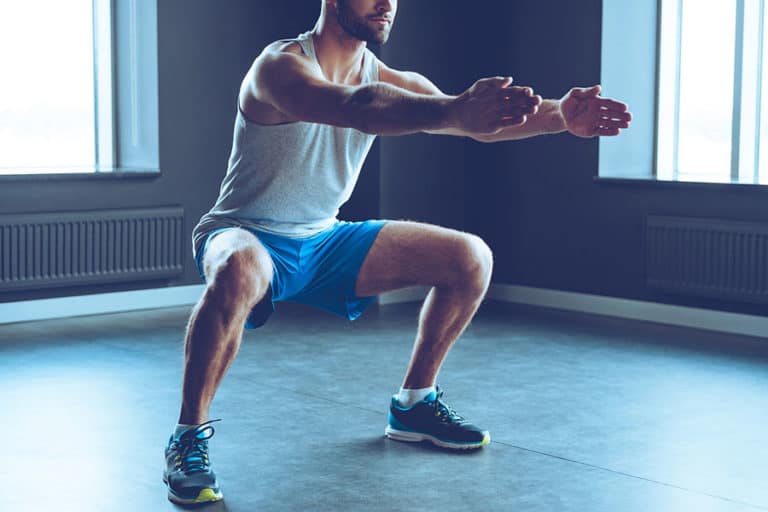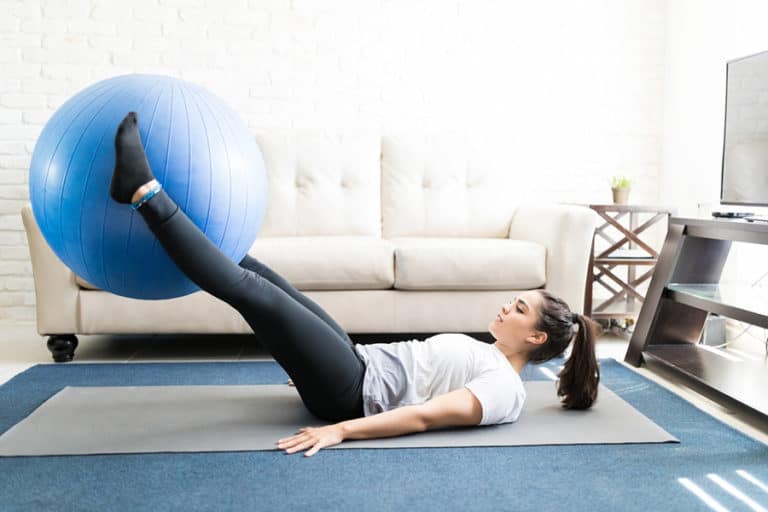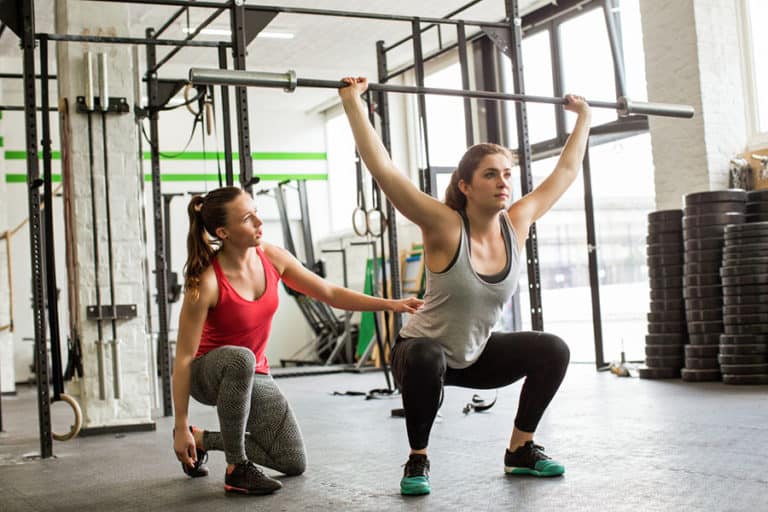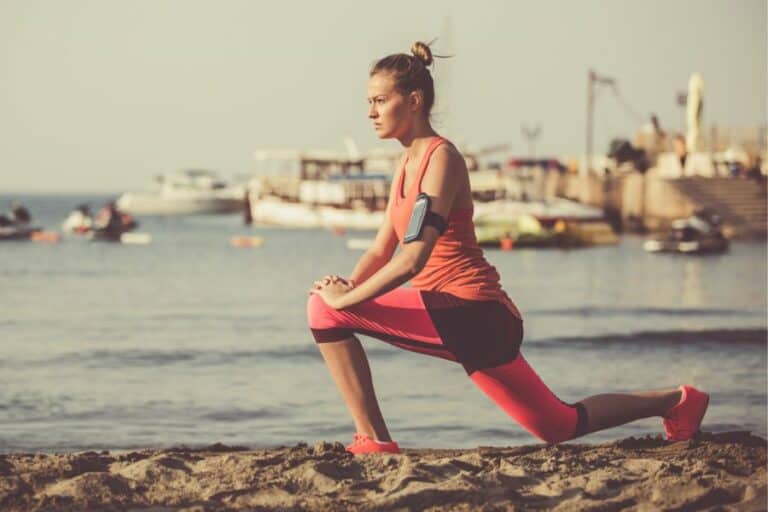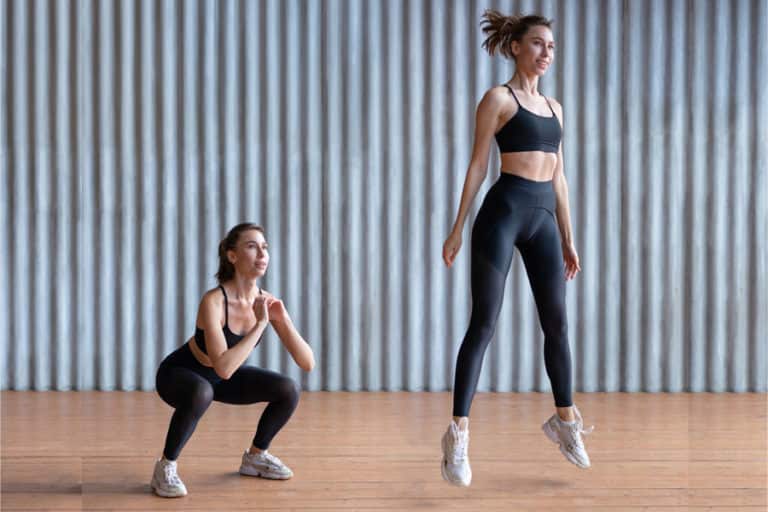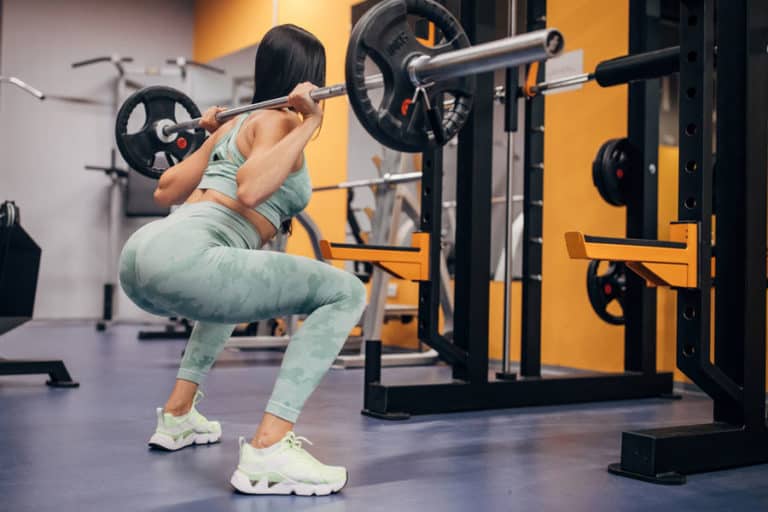Squats With Weights: 7 Types, Benefits, And Safety Tips
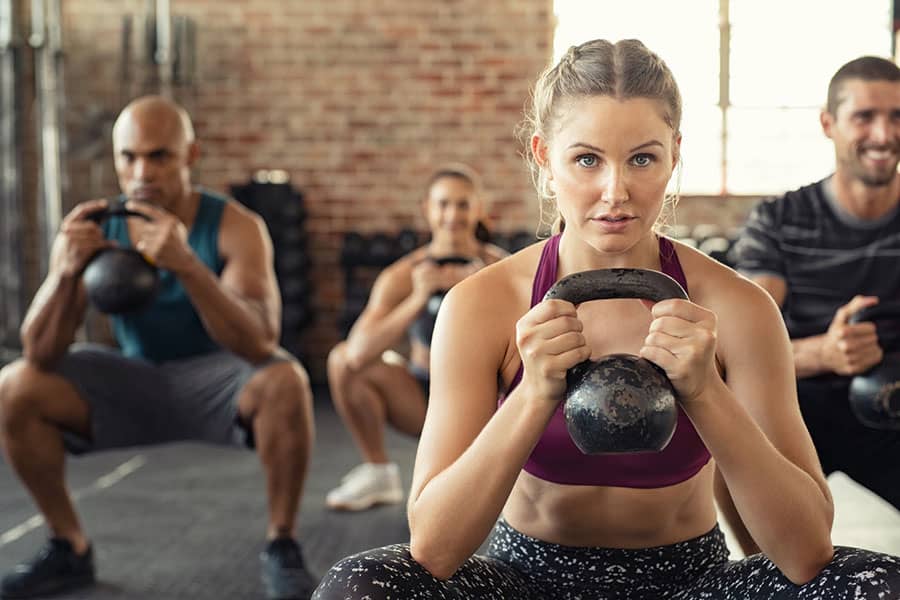
Types | Add to routine | Benefits | Safety Tips
Basic bodyweight squats are usually functional, lower-body exercises. Converting them into weighted squats transforms these squats into full-body, compound exercises. Performing squats with weight is the way to go if you wish to speed up and increase your gains from squat workouts.
7 types of squats with weights
Nearly every variant of the bodyweight squat can be transformed into weighted squats. Meanwhile, some variants are meant to be performed specifically with weights or specialized equipment. Below, we have put together 7 types of squats you can perform with weights.
1. Goblet squats
Target muscles: Glutes, quads, thighs, traps, lats, biceps, triceps, and core
How to do
- Stand with your feet shoulder-width apart.
- Hold a kettlebell at chest level gripping its horns with an overhand grip (both hands).
- Keep your core braced, elbows to your sides, and back straight.
- Lower your hips until it rests below your knees.
- Pause for a moment, press your feet firmly on the ground, push through your heels and return to the starting position.
Summary: Goblet squats are one of the safest forms of weighted squats. The kettlebell held in the front acts as a counterbalance, making it easier to squat. It helps to balance the spine, perfect any beginner’s squat form, and to prepare them for lifting weights.
2. Weighted pistol squat
Target muscles: Glutes, quads, hamstrings, hip muscles, biceps, and core muscles
How to do
- Stand with your feet shoulder-width apart and toes pointed forward.
- Grip a dumbbell (horizontally) or a kettlebell (vertically, by the horns) with both hands.
- Keep your chest high and spine neutral.
- Slowly extend your right leg straight ahead while balancing your body weight on the left leg.
- Lower your hips into a deep single-leg squat.
- Pause at the bottom of the move, press your left foot firmly and drive upwards, pushing through your heels.
- Repeat this movement with the opposite leg.
Summary: The basic pistol squats are challenging and unilateral bodyweight squats. Adding weights to this squat form can make it surprisingly easier to perform. This is because adding a weight provides a counterbalance [1]Australian Fitness Academy: THE BENEFITS OF PISTOL SQUATS FOR STRONG AND FUNCTIONAL LEGS, making it easier to shift the weight onto the heel.
3. Hack squat
Target muscles: Quads, hamstrings, glutes, calves, and core
How to do
- Load the hack machine with the desired amount of weight.
- Position your feet hip-width apart on the footplate and grip the side handles.
- Keeping your back flat and core engaged, lower your hips until your thighs are parallel to the floor.
- Extend your knees and press through your heels to return to the starting position.
Summary: Hack squats are a great exercise for targeting the quads. They are relatively easy to perform since the machine ensures good form and controlled movement.
4. Box squat
Target muscles: Quads, glutes, hamstrings, lower back, and core muscles
How to do
- Set up a squat rack with a barbell of optimum weight and set it at a height convenient to you.
- Place a plyometric box 1-2 feet away from the rack and position yourself inside the rack.
- Unrack the barbell and place it across your back and shoulders.
- With your feet shoulder-width apart and core tight, drive your hips down.
- Squat till your glutes tap the box.
- Press through your heels and return to the starting position.
Summary: Box squats are excellent for building lower-body strength and improving squat technique. The box provides stability and acts as a marker for the correct squatting depth.
5. Back squat
Target muscles: Quads, glutes, adductors, calves, hamstrings, lower back muscles, and core muscles
How to do
- Place the barbell across your shoulders (crossing the nape).
- Hold the bar with an overhand grip(palms facing outwards).
- Keeping your core engaged and back straight, lower your hips until your thighs are parallel to the floor.
- Slowly drive through your heels and return to the starting position.
Summary: The back squat is a highly challenging and effective exercise. It works several muscle groups in the upper and lower body, giving you a comprehensive workout. This squat is a good addition to any workout routine aimed at overall strength-building and muscle development.
6. Front squat
Target muscles: Quads, glutes, adductors, calves, hamstrings, lower back muscles, and core muscles
How to do
- Place the barbell across the front of your shoulders (crossing the neck).
- Grip the barbell with both hands and keep your elbows parallel to the ground.
- Brace your core and lower your hips until your thighs are parallel to the floor.
- Push through your heels and rise to the starting position.
Summary: The front squat is another excellent squat variation that targets many of the same muscles as the back squat. Consequently, it helps to increase lower-body muscle mass.
7. Landmine squat
Target muscles: Quads, glutes, trapezius muscles, deltoids, and core
How to do
- Place one end of a barbell on a landmine device and stand facing the other end of it.
- Grip the end of the barbell with both hands joined in a clasp. The end of the barbell should be at chest height.
- Stand with your feet a little more than hip-width apart.
- Hinge your hips, tighten your core and begin descending into a deep squat.
- Pause at the bottom and then explode upwards.
Summary: Landmine squats are a front-loaded movement. A 2020 study [2]Northern Michigan University: EFFECTS OF ANTERIOR-POSTERIOR LOAD PLACEMENTS IMPOSED BY A
TRANSFORMER BAR ON SQUAT BIOMECHANICS analyzing the effects of anterior (front) and posterior (back) loaded squats noted increased engagement of lower back joints and muscles in front-loaded squats. Thus, landmine squats can be a good exercise to improve lower back strength.
Add to your routine
Incorporating weighted squats into your routine is bound to improve your overall health, strength, and mobility. We have combined the squat variations mentioned above and created a workout routine.
| Days | Squat type | Sets/reps to do |
| Monday | Goblet squats Box squats Landmine squats | 3-4 sets of 10-12 reps 3-4 sets of 10-12 reps 3-4 sets of 10-15 reps |
| Tuesday | Weighted pistol squats Hack squats Front squats | 2-3 sets of 10-15 reps on each side 2-3 sets of 10-12 reps 2-3 sets of 8-10 reps |
| Wednesday | Rest | Rest |
| Thursday | Landmine squats Back squats Goblet squats | 3 -4 sets of 10-15 reps 2-3 sets of 8-10reps 3-4 sets of 10-12 reps |
| Friday | Rest | Rest |
| Saturday | Weighted pistol squats Hack squats Box squats | 2-3 sets of 10-15 reps on each side 2-3 sets of 10-12 reps 3-4 sets of 10-12 reps |
| Sunday | Rest | Rest |
Note: The number of sets and reps you must perform can vary according to factors like fitness levels, physical conditions, age, sex and so on. Perform these squats under the guidance of a fitness expert or a personal trainer
Benefits of weighted squats
Performing squats with weights is a great way to amplify the benefits gained from squats. The benefits can range from improvements in the squat form to an increase in muscle mass. Let us take a look at some of the major benefits of performing weighted squats.
1. Compound benefits
Bodyweight squats tend to be primarily lower-body focused. Adding weights to this exercise recruits the back, shoulders, and arm muscles. Weighted squats also have a greater core muscle engagement [3]ResearchGate: Activation of Selected Core Muscles during Squatting rate than bodyweight squats.
2. Muscle growth (hypertrophy)
The rate of hypertrophy (muscle building) in the body is directly proportional to the amount of weight you load.
When you add weight to your squat workout, it results in microscopic muscle damage. This stimulates the enlargement of the muscle fibers as a form of recovery and adaptation to external stressors.
The more weight you load, the higher will be the rate of muscle adaptation and enlargement.
3. Caloric burn
Your body’s capacity to burn calories is directly proportional to the amount of muscle mass it has developed. Weighted squat workouts result in a higher rate of muscle building. Given that the leg region contains some of the largest muscles in the body, performing weighted variants of lower-body workouts like squats can ensure increased levels of calorie burn in the body.
4. Prevents injury
When performed with the right form, grip, and complete range of motion, your weighted squat exercises can prevent the risk of injury. Weights often act as a counterbalance resulting in better squat form. This leads to better stability in the hip, knee, and ankle joints, which in turn results in a lower risk of injuries.
5. Improves sprinting ability
Performing loaded (weighted) squats regularly improves sprinting skills [4]National Library of Medicine: Relationships Between Vertical Jump and Full Squat Power Outputs With Sprint Times in U21 Soccer Players due to increased power output. Over time the body becomes more capable of generating power quickly, and this capacity is directly linked to enhanced running abilities.
Safety tips
Depending on how safely you perform squats with weights, the exercise can be either safe or dangerous. Let us take a look at some tips to ensure your safety while performing weighted squats.
- Never skip the warm-up. You need to get your body ready and activated for workouts as challenging as these.
- Use a weight that is comfortable for you to lift. Start light and gradually increase the weight as you get stronger.
- Maintain good form throughout the exercise. Do not let your knees cave inwards, keep your chest up, and do not round your back.
- Different squat variations might require different kinds of hand placement, wrist alignment, and grasps. Seek expert guidance to ensure that you are handling the weights correctly.
- Perform squats through a complete range of motion. Incomplete movements, bouncing at the bottom of the squat, or driving upwards before completing the downward phase can all render the workout ineffective or cause muscle injuries.
- Squats with weights are a challenging exercise, and it is important to be able to gauge your physical abilities realistically.
- If you feel any pain during the workout, stop the exercise immediately and consult a doctor.
Conclusion
Squats with weights can prove to be immensely beneficial or extremely dangerous, depending on how they are performed. You are recommended to perform these exercises under your personal fitness coach’s supervision.
References
| ↑1 | Australian Fitness Academy: THE BENEFITS OF PISTOL SQUATS FOR STRONG AND FUNCTIONAL LEGS |
|---|---|
| ↑2 | Northern Michigan University: EFFECTS OF ANTERIOR-POSTERIOR LOAD PLACEMENTS IMPOSED BY A TRANSFORMER BAR ON SQUAT BIOMECHANICS |
| ↑3 | ResearchGate: Activation of Selected Core Muscles during Squatting |
| ↑4 | National Library of Medicine: Relationships Between Vertical Jump and Full Squat Power Outputs With Sprint Times in U21 Soccer Players |


